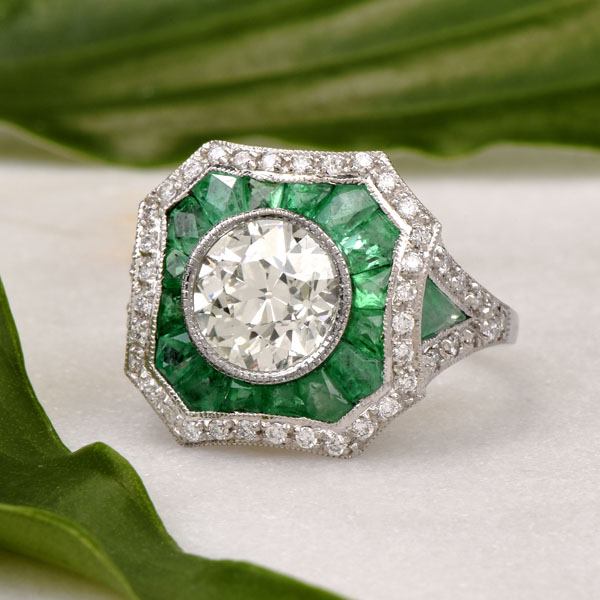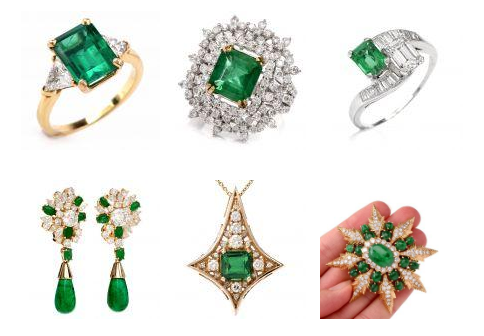
Emerald: May Birthstone & Spring Engagement
Considered a symbol of ‘rebirth and good fortune’, emerald is the official birthstone for the calendar month of May and the gemstone for the 20th and 35th marriage anniversaries.
In ancient Rome, emerald was considered to be related to Venus, their Goddess of love and beauty, and in ancient Egypt, the gemstone was known as ‘the lovers’ stone’ believed to strengthen enduring bond between couples.
Emerald The New Spring Engagement Ring
Due to it’s romantic symbolism Along with diamond, emerald has, for a very long time, ranked as a distinct choice for engagement rings. It is worth noting that the trend in recent years indicates the increased popularity of non-traditional emerald engagement rings compared to diamond rings. The new trend is attributable to the fact that selecting a non-traditional precious stone in lieu of the traditional diamond is an expression of one’s taste and individuality.
Dover Jewelry & Diamonds invites you to discover our unique collection of antique, vintage and estate emerald jewelry, amongst which the most appealing varieties of certified Colombian emerald engagement rings as well as emerald earrings, antique emerald brooches, designer emerald pendant necklaces and emerald bracelets and the like.

A Color Reminiscent of Spring…
The color of emerald, which is the most esteemed member of the beryl family of minerals, has been described by many sources as the ‘warm green of a meadow in spring” Emerald’s primary green color shows a bluish or yellowish undertone and the vivid, slightly bluish green happens to be the most desirable and highly prized variety of the gemstone.
Sources of Emerald around the World
The main deposits of emeralds are mined in Colombia, Brazil and Zambia. Emeralds are also found in other parts of the world including Pakistan, Afghanistan, Russia, Australia and United States bust the latter are secondary rather than main sources of mining emerald.
The highest quality of emerald with a silky green hue comes from Colombia which also occupies the first place on the gemstone’s price list compared to varieties of distinct provenance.
Emerald’s ‘Jardins’
Emerald is a precious stone with natural inherent inclusions. These referred to by French gemologists as ‘jardins’, does not reduce the value of the stone, but rather adds to the intensity of its color and confirms its authenticity, as synthetic emeralds would be free of inclusions. Most emeralds receive treatment to enhance their appearance. Completely untreated gems are extremely rare and whenever available, would occupy the top rank on the price scale. Treating emeralds with (Cedar) oil is a generally accepted practice and the most common method of treating emeralds.
A Gemstone of Brittle Nature
Emeralds do not possess the degree of hardness enjoyed by diamond and can, therefore, be fractured in the process of handling or setting. They do, however, last a very long time! They could be scratched when coming into contact with a sharp object, but such scratches can be wiped off.
Emerald Purchasing Guide: Selecting Authentic Emeralds
Dover Jewelry & Diamonds’ knowledgeable and experienced staff would be happy to provide you with all necessary guidelines in selecting and purchasing your desired emerald engagement ring or any other emerald piece of jewelry you wish to add to your wardrobe.
- Visible Veins, Fractures and Inclusions:
Natural emeralds have resulted from geological events occurring in the Earth’s crust since millions of years ago, forming one molecule at a time under specific conditions, Such evolutions have produced what is known as ‘hydrothermal ‘veins’. Colombian emeralds, are formed in this manner. Only the finest quality emeralds are clear and flawless. Most have tiny mineral inclusions or fractures or ‘jardins’ Flawless emeralds are rare and extremely valuable and usually only found in small sizes. Most large emeralds have inclusions which are sometimes not visible to the naked eye, especially in high quality stones. In these, they are very faint and only show up in a 10x, 20x, or 40x magnifying glasses. - Shape of Inclusions
To determine the shape of emerald’s inclusions, examine the gemstone with a magnifying glass, holding it in a position to let the light enter through an oblique angle. If you see tiny flaws or irregular patterns within the stone, it is most probably a real gem. If the gem is very clear, with almost none of these “inclusions,” it may be a synthetic emerald. - Gas Bubbles
Gas bubbles are visible only in authentic emeralds and are found in addition to different shapes of inclusions. A swarm of gas bubbles alone, without inclusions inside the gem is not sufficient proof for the gem’s authenticity and could mean a synthetic emerald. - Sparkling Effect
Genuine emeralds would produce very little or no colorful flashes when placed under light. If the gem you are examining produces a rainbow of flashes, it is a synthetic stone. - Unrealistic Color
Emerald is as a rule green to dark green or blue-green. Purely yellow-green beryl is called heliodor, and light green beryl is called green beryl. A yellow-green gem could also be olivine or green garnet easily mistaken with emerald. - Layers of Materials
Some synthetic or imitation gemstones consist of several layers of different materials, such as a green layer placed between two colorless stones, which are more easily visible if the stone is unmounted. To see them, the stone should be immersed in water and viewed from the side. This procedure would be more difficult in the case of mounted stones and should be assigned to an expert. - Unrealistic Price
The price of a natural, vividly green emerald with luster may be researched at any given time to give you an idea of the current average price of emerald, depending of course on the quality and provenance. If the price seems suspiciously low, you are probably looking at a stone other than emerald.


